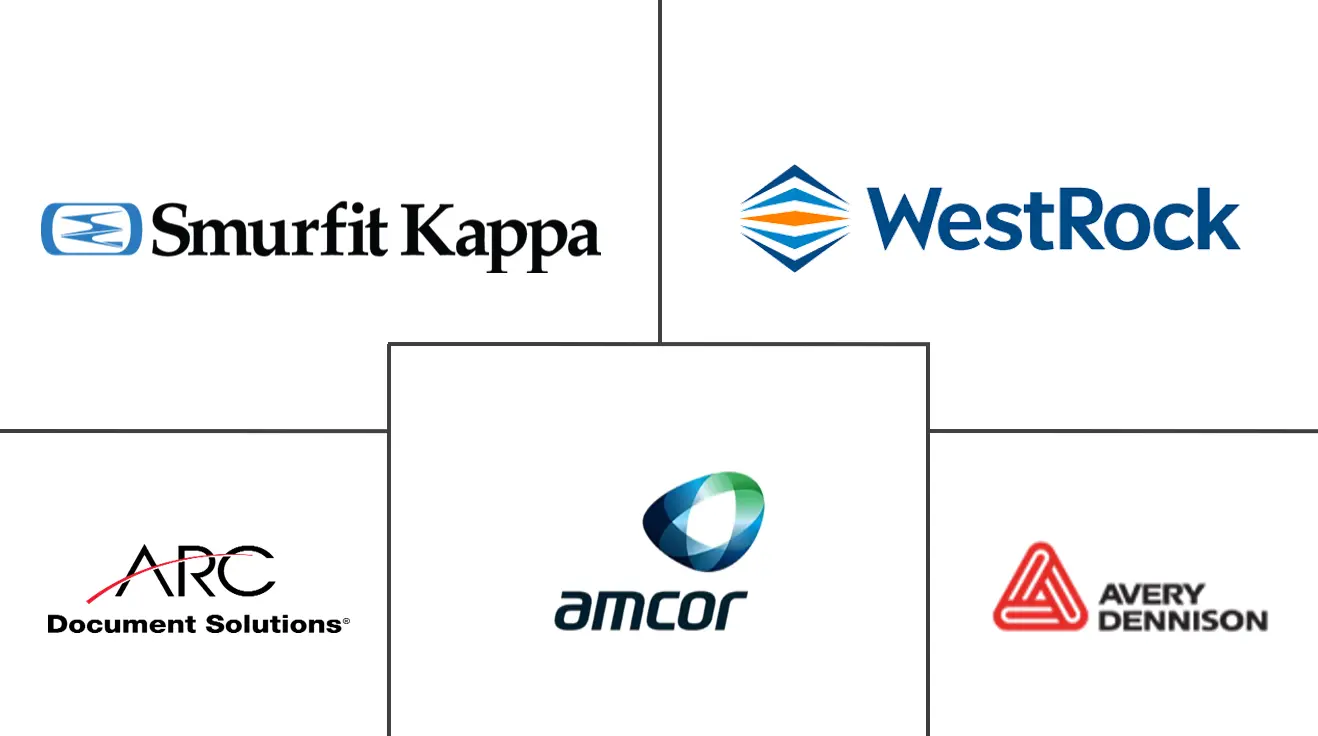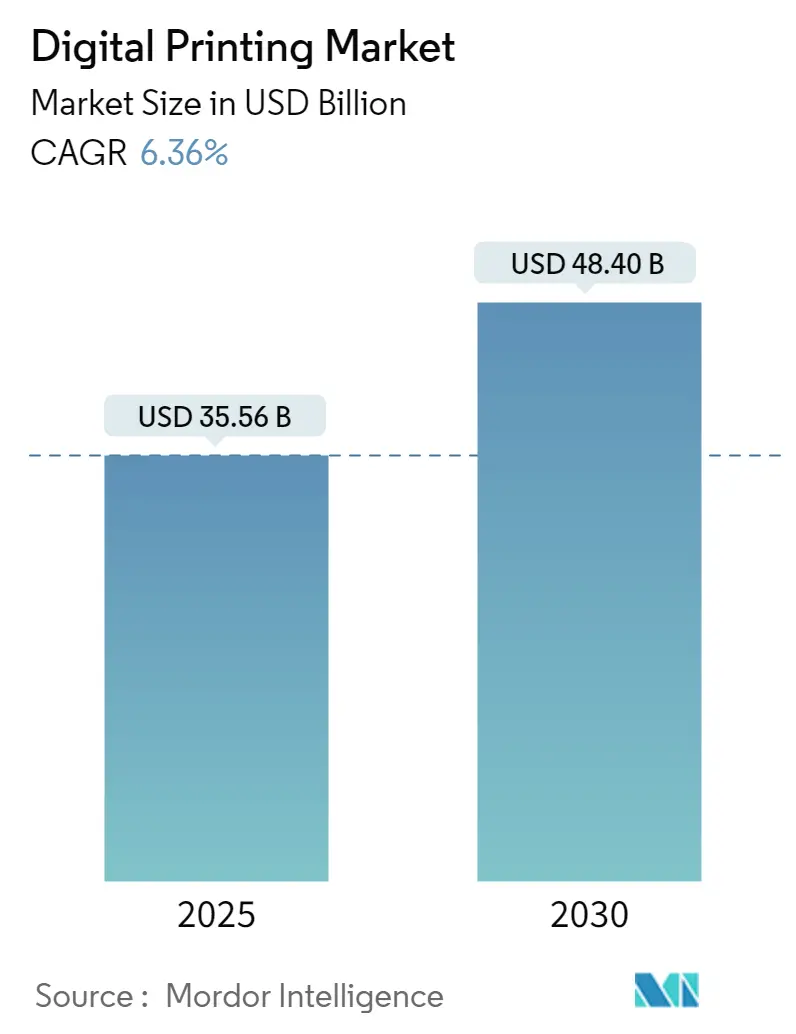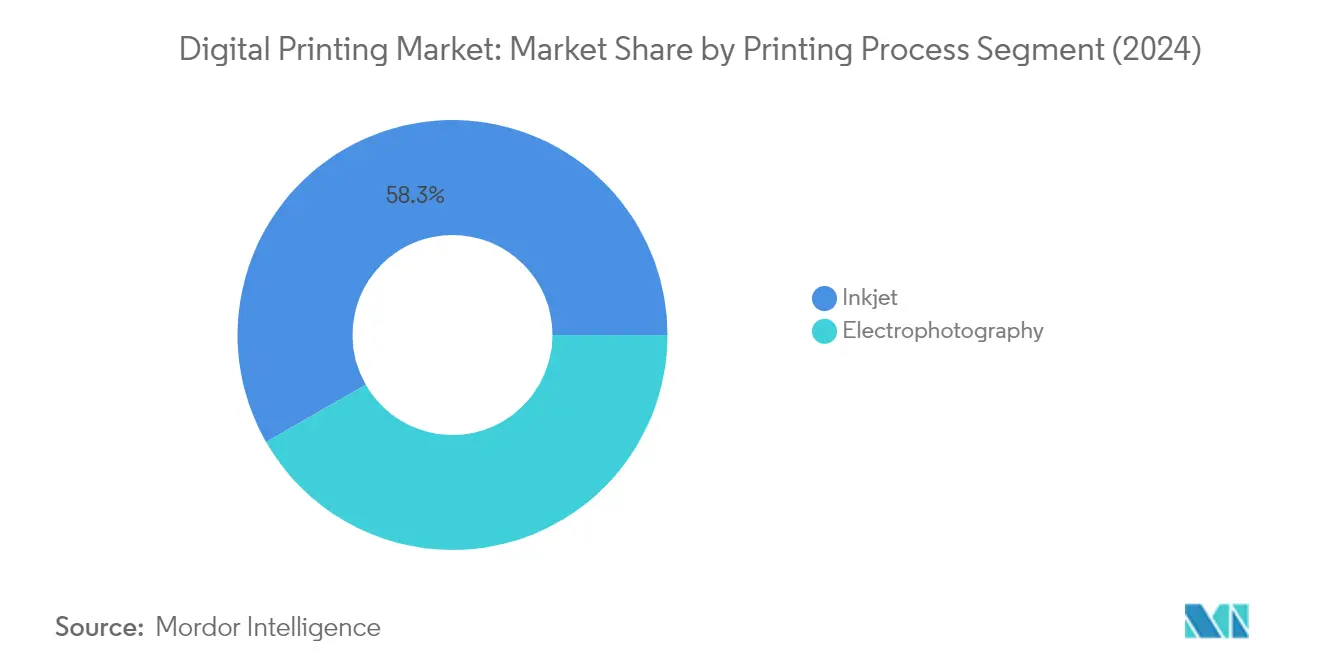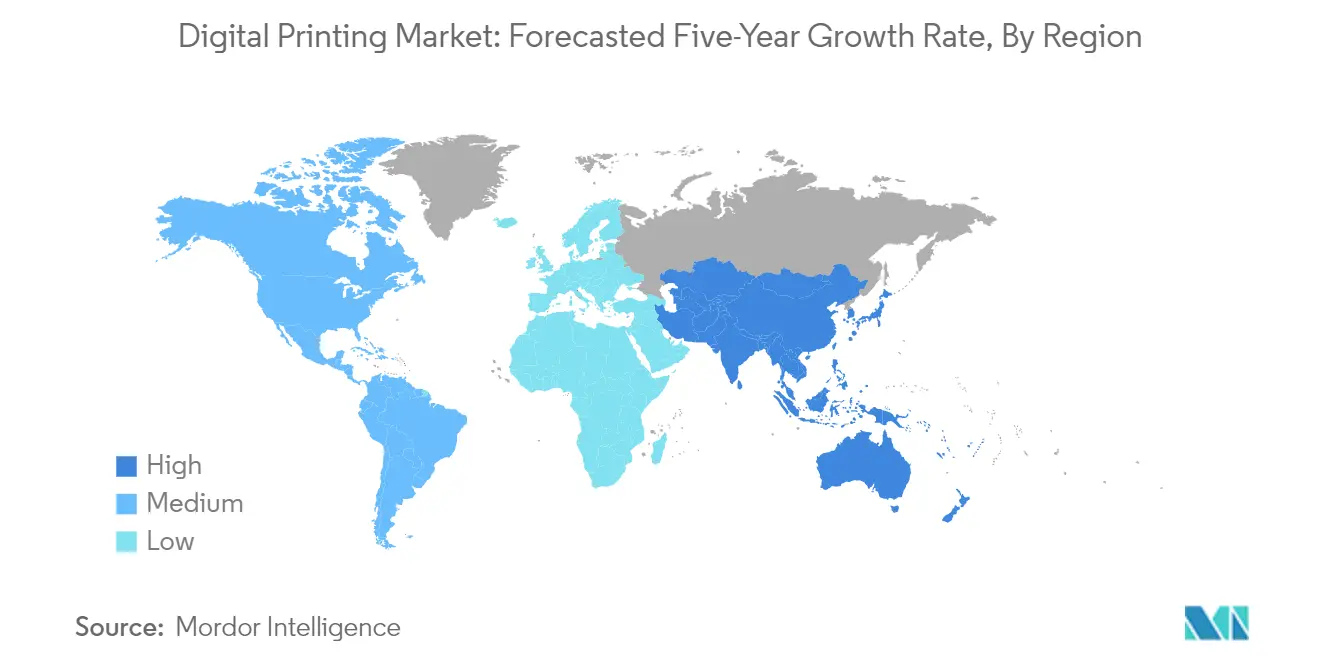Digital Printing Market Analysis
The Digital Printing Market size is worth USD 35.56 Billion in 2025, growing at an 6.36% CAGR and is forecast to hit USD 48.40 Billion by 2030.
The digital printing industry is experiencing significant transformation driven by technological advancements and changing consumer preferences. The integration of artificial intelligence, machine learning, IoT, and data analytics has revolutionized personalization capabilities in printing operations, enabling superior customization even for large-volume orders. According to Walmart, their U.S. eCommerce sales reached USD 47.8 billion in 2022, highlighting the growing demand for digitally printed packaging and marketing materials in the e-commerce sector. The industry's focus has shifted towards sustainable practices, with companies adopting mild solvents and less harmful chemicals compared to conventional printing technologies, demonstrating a clear commitment to environmental responsibility.
The convergence of digital printing with advanced technologies has led to remarkable improvements in manufacturing efficiency and supply chain management. Print service providers are increasingly adopting cloud-based solutions for better workflow management and quality control. For instance, in April 2022, Canon U.S.A. introduced the PRISMAcolor Manager solution, enabling users to evaluate and monitor print quality while comparing printed colors against industry specifications. This trend towards digital transformation is further evidenced by strategic acquisitions, such as the Agfa-Gevaert Group's acquisition of Inca Digital Printers in April 2022, which strengthened their position in high-speed digital printing technology.
The industry is witnessing a significant shift in commercial printing applications, with a growing emphasis on short-run and customized printing solutions. According to industry experts NK Pak, demand in the packaging sector alone is growing by 3-4% annually, driven by the need for personalized and short-batch production runs. The market is experiencing increased adoption of digital printing in various sectors, including packaging, textiles, and commercial printing, with companies investing in advanced digital presses that offer improved speed, quality, and flexibility.
The emergence of web-to-print technology and on-demand printing services has revolutionized the industry's business model. Digital printing companies are expanding their service offerings to include integrated solutions that combine printing with data management, design services, and fulfillment capabilities. The Middle Eastern market has shown particular enthusiasm for digital transformation, with the Department of Economic Development (DED Dubai) reporting that merchants with online platforms experienced a 26% increase in activity in the UAE and 27% in Saudi Arabia, indicating strong regional growth potential for digital printing services. This trend is complemented by the industry's focus on developing innovative solutions for various applications, from packaging to textile printing, while maintaining high quality and cost-effectiveness.
Key Market Trends
Growth of Packaging and Textile Industries and Rising Demand for Digital Advertisements
The digital printing market has been experiencing a significant transformation with the adoption of innovative technologies aimed at meeting dynamic design demands from consumers, brands, and allied supply chains. Digital printing has revolutionized textile printing by enabling just-in-time production of any length of fabrics or garments, eliminating the need for cylinders or screens. With sophisticated workflow automation tools, textile mills can now rapidly produce any design to meet the needs of designers and brands, which is particularly crucial in the fast-changing fashion industry. This technological shift has also led to improved inventory planning, resulting in reduced overstock and warehousing needs, as textile service providers transition from longer runs to short, varied, targeted production.
The packaging industry has witnessed substantial growth in digital printing trends across various segments, including cartons, labels, metal packaging, rigid plastic packaging, corrugated packaging, and flexible packaging. The corrugated packaging sector, in particular, has seen remarkable advancement with high-speed single-pass inkjet presses capable of handling thousands of sheets per hour. These digital presses offer significant advantages over traditional litho presses, especially for large retail goods packaging where conventional methods would require multiple sheets to be laminated together. Companies like Complete Design & Packaging (CDP) are doubling down on their investments in single-pass inkjet digital print technology, demonstrating the industry's confidence in digital solutions for innovative packaging applications.
Reduction in Per Unit Cost of Printing with Digital Printers
The digital printing industry has achieved significant cost efficiencies through technological advancements and operational improvements. As run lengths decrease and label variants increase, digital printing technology has become essential for meeting tight deadlines while maintaining cost-effectiveness. The reduction in per-unit printing costs is primarily driven by improved operating costs and enhanced printer productivity, particularly with developments in technologies such as HP's LEP and LEPX solutions for labels, packaging, commercial, and photo segments. These advancements have made it economically viable to produce shorter runs and handle customization requirements that were previously cost-prohibitive with traditional printing methods.
The cost advantages of digital printing extend beyond direct production expenses to include reduced waste, faster turnaround times, and the elimination of the need for printing plates. Digital presses now enable print service providers to handle on-demand and variable data print jobs while maintaining the quality, color stability, and robustness of offset presses. For instance, modern digital printers can achieve picture quality and print speeds comparable to conventional analog printers, thanks to their 1200-dpi resolution and high-frequency driving capabilities. This technological progress has made it possible for companies to offer customized packaging and printing solutions at competitive prices, particularly beneficial for short-run productions and personalized printing requirements that traditionally incurred high setup costs with conventional printing methods. The printing industry forecast indicates a continued rise in the adoption of these technologies.
Segment Analysis: Printing Process
Inkjet Segment in Digital Printing Market
The inkjet segment dominates the digital printing market, commanding approximately 58% market share in 2024, driven by its versatility and superior performance across various applications. This technology has revolutionized the printing industry through its ability to deliver high-quality outputs while maintaining cost-effectiveness for both short and medium print runs. The segment's growth is propelled by continuous technological advancements in printhead technology, ink formulations, and substrate compatibility. Inkjet printing has gained significant traction in commercial printing, packaging, and textile applications due to its ability to handle a wide range of materials and deliver precise, high-resolution outputs. The segment is experiencing robust growth with a projected growth rate of nearly 8% from 2024 to 2029, supported by increasing demand for customized printing solutions and the technology's expanding capabilities in industrial digital printing applications.
Electrophotography Segment in Digital Printing Market
The electrophotography segment maintains a significant presence in the digital printing industry, leveraging its established reputation for reliability and consistent print quality. This technology continues to evolve with improvements in color printing quality that now rivals or exceeds traditional offset printing capabilities. The segment has particularly strong adoption in commercial printing applications where precision and reliability are paramount. Electrophotography's strength lies in its ability to handle high-volume production runs while maintaining consistent quality throughout the print job. The technology has found extensive applications in book printing, commercial documents, and marketing materials, where its quick turnaround capabilities and superior text quality are highly valued. Recent technological advancements have focused on enhancing color accuracy, expanding media compatibility, and improving overall operational efficiency.
Segment Analysis: Application
Commercial Printing Segment in Digital Printing Market
Commercial printing dominates the digital printing market, commanding approximately 69% market share in 2024. This segment's prominence is driven by the growing advertising needs of enterprises across the globe, along with extensive technological proliferation. Organizations are increasingly adopting digital printers as they prove more cost-effective and efficient for bulk printing operations. The segment benefits from Wi-Fi-enabled printers and high-efficiency inks with ink tanks, allowing users to stock up on ink and expect high page yields. B2 Inkjet has emerged as a preferred choice for production inkjet press, offering advantages like lower operating costs, higher productivity through multi-up impositions, and compatibility with common commercial substrates. This reflects a comprehensive printing market analysis.
Packaging Segment in Digital Printing Market
The packaging segment is experiencing the most robust growth in the digital printing market, with an expected growth rate of approximately 9% during 2024-2029. This accelerated growth is driven by the increasing adoption of digital printing in various packaging applications including labels, corrugated packaging, cartons, and flexible packaging. The shift towards digital printing in packaging is fueled by the growing demand for personalized packaging, shorter production runs, and the need for quick turnaround times. The segment is witnessing significant innovations in sustainable packaging solutions and smart packaging technologies, which are further driving its growth trajectory.
Remaining Segments in Application Segmentation
The books segment represents a significant portion of the digital printing market, offering solutions for publishing houses and authors. This segment encompasses the printing of books, newspapers, magazines, photobooks, directories, and catalogs. Digital printing technology in this segment enables cost-effective printing of smaller runs, particularly beneficial for print-on-demand (POD) services and short-run printing. The technology allows publishers to have better control over costs and inventories while finding new revenue streams from reprints, backlists, and out-of-print titles.
Digital Printing Market Geography Segment Analysis
Digital Printing Market in North America
North America represents a mature and technologically advanced digital printing market, driven by the rapid adoption of innovative digital printing technologies across various sectors. The United States and Canada form the key markets in this region, with a strong presence in commercial printing, packaging, and textile applications. The region benefits from well-established infrastructure, high digital literacy, and increasing demand for customized printing solutions across various industries, including packaging, textiles, and commercial printing sectors.
Digital Printing Market in United States
The United States dominates the North American digital printing market, accounting for approximately 89% of the regional market share in 2024. The country's market is characterized by the strong presence of major industry players, advanced technological infrastructure, and high adoption rates across various end-user industries. The growth is primarily driven by increasing demand from the e-commerce sector, rising adoption of digital textile printing, and a growing preference for sustainable printing solutions. The country has witnessed significant investments in digital printing technologies, particularly in sectors like packaging, commercial printing, and labels.
Digital Printing Market in Canada
Canada emerges as the fastest-growing market in North America, with a projected growth rate of approximately 7% during 2024-2029. The Canadian market is experiencing rapid transformation driven by increasing adoption of digital printing solutions in packaging and commercial printing sectors. The country's growth is supported by rising e-commerce activities, growing demand for sustainable printing solutions, and increasing investments in digital printing infrastructure. Canadian businesses are increasingly adopting digital printing technologies to meet the growing demand for personalized and short-run printing requirements.
Digital Printing Market in Europe
Europe represents a significant digital printing market, characterized by a strong presence across multiple countries, including Germany, the United Kingdom, France, Italy, Spain, the Netherlands, Russia, and Poland. The region's market is driven by technological advancements, increasing adoption of sustainable printing solutions, and growing demand from various end-user industries. European countries are witnessing significant transformation in printing technologies, with an increasing focus on environmental sustainability and customization capabilities.
Digital Printing Market in Germany
Germany leads the European digital printing market, holding approximately 16% of the regional market share in 2024. The country's dominant position is attributed to its strong industrial base, technological advancement, and high adoption rates across various sectors. German manufacturers are at the forefront of implementing innovative digital printing solutions, particularly in the packaging and textile industries. The market benefits from the strong presence of major industry players, robust infrastructure, and increasing demand for customized printing solutions.
Digital Printing Market in Germany - Growth Perspective
Germany also emerges as the fastest-growing market in Europe, with an expected growth rate of approximately 7% during 2024-2029. The country's growth is driven by increasing investments in digital printing technologies, rising demand for sustainable printing solutions, and growing adoption across various end-user industries. German businesses are increasingly embracing digital printing technologies to meet evolving customer demands for personalization and quick turnaround times. The market is witnessing significant developments in areas such as packaging, textile printing, and commercial printing applications.
Digital Printing Market in Asia Pacific
The Asia Pacific region represents a dynamic and rapidly evolving digital printing market, with China, India, and Japan serving as key growth drivers. The region's market is characterized by increasing industrialization, growing adoption of digital technologies, and rising demand from various end-user industries. The market benefits from rapid technological advancement, increasing investments in printing infrastructure, and growing demand for customized printing solutions across various sectors.
Digital Printing Market in China
China dominates the Asia Pacific digital printing market as the largest market in the region. The country's market is driven by rapid industrialization, a strong presence in manufacturing sectors, and increasing adoption of digital printing technologies. Chinese manufacturers are increasingly investing in advanced digital printing solutions to meet growing domestic and international demand. The market benefits from strong government support, robust infrastructure development, and an increasing focus on technological advancement in printing industries.
Digital Printing Market in India
India emerges as the fastest-growing market in the Asia Pacific region. The Indian market is experiencing rapid transformation driven by increasing digitalization, a growing e-commerce sector, and rising demand for packaging solutions. The country's growth is supported by increasing investments in digital printing infrastructure, rising adoption across various industries, and growing demand for customized printing solutions. Indian businesses are increasingly adopting digital printing technologies to meet evolving market demands and enhance operational efficiency.
Digital Printing Market in Latin America
Latin America represents an emerging digital printing market, with Brazil and Mexico serving as key growth drivers. The region's market is characterized by increasing adoption of digital printing technologies, growing demand from packaging and textile industries, and rising investments in printing infrastructure. Brazil emerges as the largest market in the region, while Mexico shows the fastest growth potential. The market is witnessing significant developments in areas such as packaging, commercial printing, and textile printing applications, driven by increasing industrialization and growing demand for customized printing solutions.
Digital Printing Market in Middle East and Africa
The Middle East and Africa region represents an evolving digital printing market, characterized by increasing adoption of digital technologies and growing demand from various end-user industries. The region's market is driven by rapid urbanization, growing investments in printing infrastructure, and increasing demand for customized printing solutions. The market benefits from rising industrialization, a growing e-commerce sector, and an increasing focus on technological advancement in printing industries. The region shows significant potential for growth, particularly in areas such as packaging, textile printing, and commercial printing applications.
Digital Printing Industry Overview
Top Companies in Digital Printing Market
The digital printing market features established players like Smurfit Kappa, WestRock, Avery Dennison, Amcor, and DS Smith leading innovation and market development. Companies are increasingly focusing on developing sustainable printing solutions while investing heavily in R&D to enhance their digital printing capabilities and automation technologies. The printing industry is witnessing a strong trend toward customization and personalization capabilities, with major players expanding their product portfolios to include variable data printing, smart packaging solutions, and integrated digital workflows. Strategic partnerships and collaborations are becoming commonplace as companies seek to combine technological expertise and market reach. Operational excellence is being pursued through investments in advanced manufacturing facilities, while geographical expansion is driven by both organic growth and strategic acquisitions, particularly in emerging markets.
Market Structure Shows Increasing Consolidation Trends
The digital printing market exhibits a mix of global conglomerates and specialized printing solution providers, with larger players leveraging their extensive resources and distribution networks to maintain market dominance. Market consolidation is actively occurring through strategic acquisitions, as evidenced by significant moves like Clayton, Dubilier & Rice's acquisition of Multi-Color Corporation and its combination with Fort Dearborn to create a global label solutions powerhouse. The industry structure is characterized by vertically integrated players who control various aspects of the value chain, from equipment manufacturing to end-user services, while regional specialists focus on niche applications and local market requirements.
The M&A landscape is particularly dynamic, with companies pursuing acquisitions to enhance technological capabilities, expand geographical presence, and strengthen market position. Major players are acquiring smaller, innovative companies to access new technologies and customer segments, while also pursuing strategic partnerships to enhance their digital printing capabilities. The market is seeing increased participation from private equity firms, indicating strong growth potential and opportunities for consolidation. Regional players are being targeted for acquisition by global companies looking to establish a local presence and access specific market segments.
Innovation and Sustainability Drive Future Success
Success in the digital printing market increasingly depends on companies' ability to innovate while maintaining sustainable practices and operational efficiency. Incumbent players are focusing on developing comprehensive digital solutions that integrate various printing technologies with data analytics and automation capabilities. Market leaders are investing in research and development to create more environmentally friendly printing solutions, while also expanding their service offerings to include consulting and technical support. The ability to provide end-to-end solutions, from design to distribution, is becoming crucial for maintaining market share, while investment in advanced technologies like AI and IoT is helping companies differentiate their offerings.
For contenders looking to gain ground, the focus needs to be on developing specialized solutions for specific industry segments while building strong customer relationships through customized service offerings. The market shows moderate end-user concentration, with packaging and commercial printing segments representing significant opportunities for growth. Substitution risk from traditional printing methods is decreasing as digital printing technology becomes more cost-effective and versatile. Regulatory requirements, particularly regarding environmental sustainability and product safety, are becoming more stringent, requiring companies to adapt their processes and materials accordingly. Success in this evolving market will depend on companies' ability to balance innovation with cost efficiency while meeting increasingly stringent environmental standards.
Digital Printing Market Leaders
-
Westrock Company
-
Avery Dennison Corporation
-
Amcor PLC
-
Smurfit Kappa Group PLC
-
ARC Document Solutions LLC
- *Disclaimer: Major Players sorted in no particular order
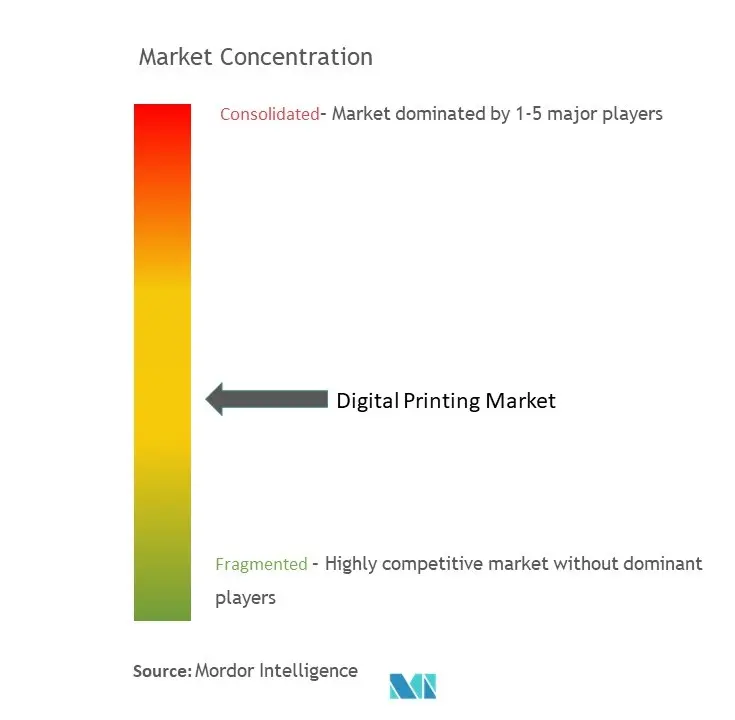
Digital Printing Market News
- February 2024: Canon India launched imagePRESS V1350 with two brand-new installations in India. The imagePRESS V1350 joins the new generation imagePRESS VSeries Printers, including the imagePRESS V1000, V900, V800, and V700.
- December 2023: Saica installed the HP PageWide C550 digital corrugated press, which works alongside its HQPP Flexo presses and will allow the company to expand its wide customer offering with digital solutions in its facility in Navarra, Spain.
Digital Printing Market Report - Table of Contents
1. INTRODUCTION
- 1.1 Study Assumptions and Market Definition
- 1.2 Scope of the Study
2. RESEARCH METHODOLOGY
3. EXECUTIVE SUMMARY
4. MARKET INSIGHTS
- 4.1 Market Overview
-
4.2 Industry Attractiveness - Porter's Five Forces Analysis
- 4.2.1 Bargaining Power of Suppliers
- 4.2.2 Bargaining Power of Buyers
- 4.2.3 Threat of New Entrants
- 4.2.4 Threat of Substitute Products
- 4.2.5 Intensity of Competitive Rivalry
- 4.3 Technology Snapshot
5. MARKET DYNAMICS
-
5.1 Market Drivers
- 5.1.1 Growth of Packaging and Textile Industries and Rising Demand for Digital Advertisements
- 5.1.2 Reduction in Per Unit Cost of Printing with Digital Printers
-
5.2 Market Restraints
- 5.2.1 Investment in R&D Activities and Additional Capital Expenditure
6. MARKET SEGMENTATION
-
6.1 By Printing Process
- 6.1.1 Electrophotography
- 6.1.2 Inkjet
-
6.2 By Application
- 6.2.1 Books
- 6.2.2 Commercial Printing
- 6.2.3 Packaging
- 6.2.3.1 Labels
- 6.2.3.2 Corrugated Packaging
- 6.2.3.3 Cartons
- 6.2.3.4 Flexible Packaging
- 6.2.3.5 Rigid Plastic Packaging
- 6.2.3.6 Metal Packaging
-
6.3 By Geography***
- 6.3.1 North America
- 6.3.1.1 United States
- 6.3.1.2 Canada
- 6.3.2 Europe
- 6.3.2.1 United Kingdom
- 6.3.2.2 Germany
- 6.3.2.3 France
- 6.3.2.4 Italy
- 6.3.2.5 Spain
- 6.3.2.6 Netherlands
- 6.3.2.7 Poland
- 6.3.3 Asia
- 6.3.3.1 China
- 6.3.3.2 India
- 6.3.3.3 Japan
- 6.3.3.4 Australia and New Zealand
- 6.3.4 Latin America
- 6.3.4.1 Brazil
- 6.3.4.2 Mexico
- 6.3.5 Middle East and Africa
- 6.3.5.1 United Arab Emirates
- 6.3.5.2 South Africa
- 6.3.5.3 Saudi Arabia
- 6.3.5.4 Egypt
7. COMPETITIVE LANDSCAPE
-
7.1 Company Profiles
- 7.1.1 Smurfit Kappa Group PLC
- 7.1.2 Westrock Company
- 7.1.3 Southland Printing Company Inc.
- 7.1.4 IronMark Inc.
- 7.1.5 Xeikon NV
- 7.1.6 ARC Document Solutions LLC
- 7.1.7 Avery Dennison Corporation
- 7.1.8 Multi Color Corporation
- 7.1.9 Amcor PLC
- 7.1.10 Sato America
- 7.1.11 DS Smith PLC
- 7.1.12 Mondi PLC
- 7.1.13 CPI Corporate
- 7.1.14 Core Publishing Solutions
- 7.1.15 Command Companies
- 7.1.16 Quad/Graphics Inc.
- 7.1.17 Walsworth Publishing Company
- *List Not Exhaustive
8. INVESTMENT ANALYSIS
9. MARKET OPPORTUNITIES AND FUTURE TRENDS
Digital Printing Industry Segmentation
Digital printing is a process that incorporates on-demand, high-quality print. It represents a modern production technique that enables printing from electronic files. Furthermore, it does not need a printing plate, unlike the more conventional offset printing. The study tracks the revenue accrued from the various digital printing processes that are being used across various applications. Also, the revenue accrued from the digital printing vendors has been considered.
The Digital Printing Market is Segmented by Printing Process (Electrophotography and Inkjet), Application (Books, Commercial Printing, and Packaging [Labels, Corrugated Packaging, Cartons, Flexible Packaging, Rigid Plastic Packaging, and Metal Packaging]), and Geography (North America [United States and Canada], Europe [Germany, United Kingdom, France, Netherlands, Poland, and Rest of Europe], Asia-Pacific [China, India, Japan, and Rest of Asia-Pacific], Latin America [Brazil, Mexico, and Rest of Latin America], and Middle East and Africa [United Arab Emirates, Saudi Arabia, Egypt, South Africa, and Rest of Middle East and Africa]). The market sizes and forecasts are provided in terms of value (USD) for all the above segments.
| By Printing Process | Electrophotography | ||
| Inkjet | |||
| By Application | Books | ||
| Commercial Printing | |||
| Packaging | Labels | ||
| Corrugated Packaging | |||
| Cartons | |||
| Flexible Packaging | |||
| Rigid Plastic Packaging | |||
| Metal Packaging | |||
| By Geography*** | North America | United States | |
| Canada | |||
| Europe | United Kingdom | ||
| Germany | |||
| France | |||
| Italy | |||
| Spain | |||
| Netherlands | |||
| Poland | |||
| Asia | China | ||
| India | |||
| Japan | |||
| Australia and New Zealand | |||
| Latin America | Brazil | ||
| Mexico | |||
| Middle East and Africa | United Arab Emirates | ||
| South Africa | |||
| Saudi Arabia | |||
| Egypt | |||
Digital Printing Market Research FAQs
How big is the Digital Printing Market?
The Digital Printing Market size is worth USD 35.56 billion in 2025, growing at an 6.36% CAGR and is forecast to hit USD 48.40 billion by 2030.
What is the current Digital Printing Market size?
In 2025, the Digital Printing Market size is expected to reach USD 35.56 billion.
Which is the fastest growing region in Digital Printing Market?
Asia Pacific is estimated to grow at the highest CAGR over the forecast period (2025-2030).
Which region has the biggest share in Digital Printing Market?
In 2025, the North America accounts for the largest market share in Digital Printing Market.
What years does this Digital Printing Market cover, and what was the market size in 2024?
In 2024, the Digital Printing Market size was estimated at USD 33.30 billion. The report covers the Digital Printing Market historical market size for years: 2019, 2020, 2021, 2022, 2023 and 2024. The report also forecasts the Digital Printing Market size for years: 2025, 2026, 2027, 2028, 2029 and 2030.
Our Best Selling Reports
Digital Printing Market Research
Mordor Intelligence provides comprehensive insights into the digital printing market. We combine extensive industry expertise with detailed printing industry analysis. Our research thoroughly examines global digital printing trends. This includes commercial printing market dynamics and industrial digital printing developments. The report offers in-depth coverage of digital label printing solutions and emerging technologies. It also analyzes printing industry statistics across key regions, including North America, Europe, and Asia-Pacific.
Stakeholders benefit from our detailed printing market analysis, which includes digital printing growth projections and printing industry forecast data. The report, available as an easy-to-download PDF, offers valuable insights into digital print market size and printing business growth opportunities. Our analysis covers variable data printing trends, digital printing companies, and technological advancements shaping the industry. The report also examines printing market trends and provides print industry revenue projections. This helps businesses make informed strategic decisions in the evolving digital printing industry.

